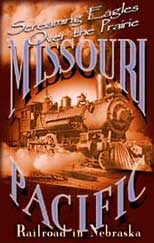
MoPac History
|
|
Sources:
Missouri Pacific River and Prairie Rails - the Missouri Pacific
in Nebraska by Michael M. Bartels
this book is invaluable with it's information of the MoPac's history
in Lincoln, as well as all of Nebraska
The
Hub of Burlington Lines West
by Holck
The
Lincoln Star & Journal
Special
Thanks to William W. Kratville, Glen
Beans, James Gilley, Michael Bartels,
J. J. Holck, and Jim McKee for letting me borrow from their photos
and research.
Every effort has been made to get the correct information on these
pages, but mistakes do happen. Reporting of any inaccuracies would
be appreciated.
All photos & text © 2000-2008 T. Greuter / ScreamingEagle@rrmail.com
unless otherwise noted.
|
|
|
 |
Being
all of 7-years old, I didn't know or care much about history. But
I did know that I was enthusiastic about trains. As far as I was
concerned, ALL engines wore Jenks Blue with the white stripes on
the nose that reminded me of "warpaint", and a huge white
eagle with claws outstretched and screaming on the sides.
As
I walked the rails in cowboy hat and boots, I didn't know all of
the story. But as I reached down to pick up an ancient cinder/clinker
my mind drifted to what it must have been like riding these rails
long, long ago.
Lincoln,
Nebraska - 1977
|
Westward
to Lincoln!
With the coming
of the Missouri Pacific to Omaha and its stockyards, it became a major
goal of the city of Lincoln to bring the railline closer to home, not
only for the benifits of competition to the other carriers, but to gain
access to southern lumber and coal. After years of talks, in 1886 the
Missouri Pacific laid track through the towns of Nehawka, Wabash, Weeping
Water, Elmwood, Eagle, Walton and Lincoln, Nebraska. Wabash and Eagle
came into being and flourished as a result of the new track being laid.
In fact, the Dec 30, 1888 issue of the Daily Nebraska State Journal
would proclaim that the MoPac had led to quite a bit of the prosperity
seen in Lincoln over the preceeding three years. The connection to southern
resources had indeed been fruitful. This branch line connected at Union
to the Omaha line, and the growing Missouri Pacific Railroad system.
Traffic from Omaha and Kansas City could reach these young communities.
The carrier originated from Missouri and constructed parts of its trackage
in Southeast Nebraska as subsidiary companies to the MoPac. Eventually
about 347 route miles would operate in Nebraska.
|
A
mileage marker just west of Eagle marks the spot where the Union
and Lincoln extensions were joined. 5/13/95
|
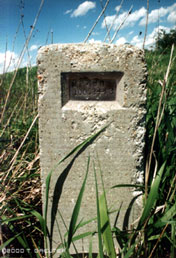 |
The Missouri Pacific
had staked it's claim in Lincoln. The original idea was to have the
line push westward, and this got as far as the Union Pacific connection
on the salt flats west of Lincoln (interchanging with UP continued here
until the merger). In the early years the rail business boomed with
transporting grain, livestock, coal, limestone, and lumber.
The 1870's and 1880's
were decades of rapid growth for small towns such as Weeping Water on
the branch or Falls City in far southeastern Nebraska. Weeping Water
experienced a building boom, with the name "Missouri Pacific"
being adopted by not only a new hotel, but also the town's baseball
team. Meanwhile down in Falls City in 1871, the coming of the Atchison
and Nebraska Railroad accelerated the town's growth, while in 1881-82,
the Missouri Pacific mainline from Omaha to Atchison, Kansas opened.
In 1909, Falls City became a division point on the Missouri Pacific
Railroad. This improved transportation access helped Falls City grow
from 607 in 1807 to 3,022 in 1900.
Weeping Water was
not only at the heart of the Union to Lincoln branch, but had become
a Missouri Pacific crossroads in 1887. Before the track to Lincoln was
finished, crews began clearing a right of way up north to Omaha and
down south to Talmage for a connection to the Crete Branch. Meanwhile,
up in Omaha the MoPac was encircling the whole city with it's own belt
line. It continued the use of UP's Omaha facilities but would no longer
merely be a "guest" of the Union Pacific there.
In 1881 The Missouri
Pacific made another stab in Nebraska further west. After some controversial
stock wheeling and dealing by rail giant Jay Gould, the Union Pacific
had aquired the Central Branch R.R.
in Concordia, Kansas - thus driving out the competition from the Kansas
Pacific R.R. The Union Pacific then leased this track to the MoPac,
which had access to Concordia by it's own line. The MoPac's aim of extending
farther west had taken another step forward. Eventually the Missouri
Pacific aquired the interest and began laying track extending northwest
from Warwick, Kansas to Prosser, Nebraska in 1887. Prosser experienced
a boom with it's own streetcars and a cotton mill, but the railroad's
aspirations languished as efforts to push up across the Platte River
and on to Kearney failed to make progress due to the lack of support.
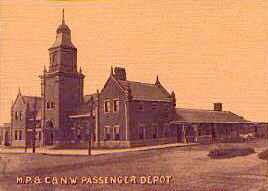 |
| Lincoln's
Union Station, jointly operated by the MoPac and C&NW, as it
appeared sometime after the turn of the century - from a postcard |
Being the northernmost
extension of the railroad, the Missouri Pacific had to face new natural
foes as well as the man-made kind. Such was the challenge of Nebraska's
unpredictable weather, which seems to prefere the extreme more often
than not... flash floods and tornadoes, grassfires, or fighting to keep
the trains from becoming snowbound during heavy snowstorms, such as
the infamous Blizzard of 1888 which prooved deadly all across the plains.
In October 1887
work began on a new brick and sandstone passenger station at Ninth and
S streets west of the University of Nebraska in Lincoln, replacing a
small frame depot. With it's Baroque style spires the new station was
decidedly a bit more elaborate than the old structure. The MoPac shared
the facility with the Freemont, Elkhorn & Missouri Valley (later
the Chicago & Northwestern) as well as some jointly operated rails.
The cooperation between the two lines would continue until the C&NW
ceased oprations in Lincoln, an arrangement that lasted 95 years. The
station came to be known as Union Depot. It was the only one in Lincoln
at the time to be used by more than one rail company. Three years after
the new passenger station, both companies moved into their new freight
depot just to the west. Though station facilities and rails were shared,
the MoPac and C&NW mantained their own additonal yard spaces and
engine terminals, surrounded by lumber warehouses, coal industry companies,
and other commercial dealers.
Railroad
Stories
There are a couple
of intriguing stories involving the MoPac in Lincoln. One story concerns
a dispute involving crossing rights which threatened to become down
right ugly back in 1890 on August 25.
The Missouri Pacific,
the Burlington & Missouri River (a predecessor of BNSF), and the Fremont,
Elkhorn & Missouri Valley (now an excursion line) were miffed at the
North Lincoln Electric Railway. The electric streetcar line, in preparation
to enter northern Lincoln, laid track between two tracks of the MoPac
near 11th and W Streets. The superintendent for the Burlington (who's
tracks paralleled the MoPac) and the attorneys for both the Elkhorn
and the Missouri Pacific were soon at the scene of the "crime".
Then the 3 railroads had moved their locomotives accompanied by a force
of 200 men to join the dispute. The stand-off lasted hours with both
sides glaring and trading insults, but gradually kept enough of their
cool, deciding to resolve the issue in the courts instead.
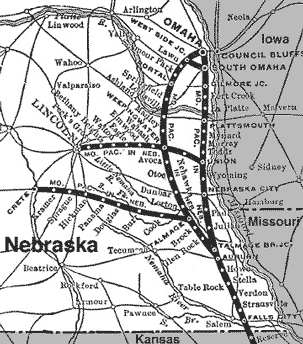 |
The next day, the
26th, a judge issued a restraining order against the railroads, prohibiting
them from interfering with the streetcar line. But by the morning of
the 27th, the streetcar company charged four Burlington officials with
disobeying the restaining order.
Now things got worse...
That afternoon the
sheriff and a deputy were called out to the disputed site. They found
the main and side tracks again occupied by the railroads' locomotives.
When ordered to move off the crossing, the engineers would only move
one locomotive at a time, constantly leaving one to block the track.
The engineers were arrested, a skirmish ensued again threatening to
become bloody, so the sheriff swore in 20 deputies armed with revolvers
(including some of the streetcar company men). The crowd was driven
back. Then a fireman had to be overpowered in order to move an engine
off the crossing, amidst cheers and jeers. The railroads were defeated,
but they left the spaces between the street car track 'paved with rails'
Accidents were a
common occurance on any railroad. Such was the case of a "lost"
train. In January 1911, a MoPac road crew unfamiliar with Lincoln left
early one morning, not realizing that the track switch was aligned for
a C&NW passenger train. The C&NW roundhouse took notice of the
unexpected sight rolling by and notified the tower at North 27th Street
to flag down the wayward train. Fortuantely they were stopped, and face
to face with the C&NW passenger train!
On July 21, 1911
the operator of a MP 4-6-0 somehow either lost balance from the cab
and fell off or jumped off to throw a switch and couldn't climb back
on the moving engine (the stories conflict). Anyway the results were
the agreed to be the same as the unmanned loco made an unscheduled stop
through the wall of the C&NW ticket office. No injuries occured,
but tickets were strewn all over among the rubble as employees rushed
to collect the booty.
There were a few
other encounters. Sharing a busy railyard in the age of steam was no
easy matter... and there were times when the foremen of the two companies
were said to have had skirmishes. But overall the MoPac and C&NW
crews worked well together.
The
City and the Railline Grows
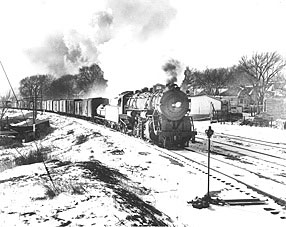 |
| MP
724 - The 2-10-2 literally fills the sky with hot steam on this
frigid 21st of January day, 1951. It would be one of the last times
steam would be seen on this mainline, as #1724 pulls a freight northward
near Lake Street in Omaha, Nebraska - photo © copyright William
W. Kratville, used with permission |
Peck's Grove, a
farm and orchard east of 33rd Street in Lincoln grew into a community
thanks to the MoPac's service to the college town. This area of open
farmland was subdivided into residential lots, and a depot was erected
by the Fall of 1886. Later on, by the 1920's, the depot would be reduced
to a shed With the coming of the postwar years a sign continued to mark
the stop, long after the city of Lincoln swallowed up the one-time farm.
And even then it was still used as a stop for neighborhood residents.
There was another flagstop farther on east to serve Bethany Heights,
another new developement around a new college, with it's depot located
at what is today's 66th Street. MoPac's motorcars were a common sight
during these years. The Bethany Heights building stood long after it
outlived it's use as a depot, being converted to an elevator scale house
in the Twenties. By then the growing city of Lincoln annexed this area
as well.
The coming of the
Burlington's Zephyr meant a new source of stiff competition facing the
Missouri Pacific in Nebraska. By August 1937 Lincoln saw its first diesels
in road service, a pair of NC2s #4100 and 4101, although appearing to
be switchers, these were painted up in the early road colors of black
with white trim (over the years MP would modify a number of switcher-types
including the addition "streamlined" cowling over the front
end reservoirs for road service). One of the new diesels handled one
or two daily passenger runs to Union, while the other switched in Lincoln
during the day, and ran round trip freight to Union at night. The countdown
clock had begun for Steam on the branchline, but not until 1951 would
the last fire would be put out.
WWII
Legacy
During wartime the
Missouri Pacific participated in the building of the Martin bomber plant
near the Fort Crook, Nebraska station. The forty-eight new buildings
constructed as well ast the airstrip were leased to the Martin-Nebraska
Co. (an arm of Glen L. Martin Co.).
Martin used the
facility to produce bombers and other aircraft. At it's peak, the Martin
Bomber plant employed 14,500 workers and turned out over 2,000 war planes,
1,585 B-26 Marauder bombers, 531 B-29 Super Fortress bombers and modified
over 1,000 other aircraft. The best known bombers of the War were products
of the Nebraska plant - the famous B-29 Enola Gay and Bock's
Car which dropped the atomic bombs on Japan and brought an end to
World War Two.
After the war, was
leased to the Army and processed prisoners of war. In 1946 the airfield
was designated as Offut Field by the Army Air Corps, ultimately becoming
Offut Air Foce Base. The former bomber plant was transformed once again
for an even bigger role, converted into the new headquarters of the
Strategic Air Command (SAC).
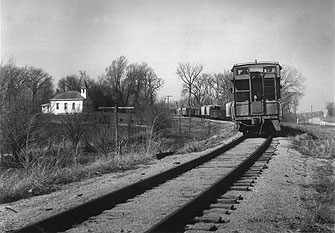 |
| A
scene once common now gone. Caboose #13408 rounds a rural curve
at Omaha, Nebraska. "Schoolhouse Bend" as pictured by
reknowned photographer William W. Kratville - © W. W. Kratville
photo, used with permission |
Growing
up in the 40's and 50's with the Eaglet
It was Feburary
1940 - Lincoln was close enough to the route of the Mopac's new streamliner
to be treated to a visit by the pre-inaugaral tour of the Eagle... even
though the Eagle didn't make a direct connection here. Excitement would
continued to be high, even billboards advertising the sleek streamliner
began to appear in town. Soon passengers would make a short trip from
Lincoln to board the new Eagle at Union. By September 1942 a double-ended
streamlined Motorailer No. 670 built by ACF was put into service on
the Lincoln branch as a compliment to the Eagle. Resplendant in attractive
blue, gray and yellow border matching those of it's now-famous parent
the motorcar was nicnamed the "Eaglette" or the "Little
Eagle". Operations required a crew of four - the railway express
agent, conductor, brakeman, and engineer. Inside its passengers were
treated to the comforts of the streamliners traveling at a sometimes
bumpy 55 mph with unequalled railtravel views from it's glassed front.
Occasionally standard motorcars or a steam engine would fill in when
the "Eaglette" was unavailable. Over a course of the next
12 years this motorcar captured the attention and hearts of Lincolnites
and came to symbolize the Missouri Pacific between Union and Lincoln.
When there was talk of its retirement in 1952, local outcries, plus
MoPac's chief executive officer Paul J. Neff brought it back into service
for another 2 years. The poor soul who originally suggested the retirement
idea was demoted.
 |
|
MP
670, the 'EAGLETTE' MotoRailer - © copyright
T.
Greuter
|
The Eaglet was a
definite hit with the local kid population, achieving fame that would
outlast it's all too brief career. A Lincoln-native now living in Eagle,
Bob Soflin writes "I grew up in Bethany Park in the 50's... along
the banks and in the depths of "Dead Mans' Run" ... where I used to
fish for crawdads under the creek bridge between Cotner and 66th South
of Vine. The banked curve between 56th and Cotner offered many hours
of pleasure walking the rails waiting for the Eaglet and the daily freight.
When no trains were expected the creek offered a diversion and when
that didn't entertain us we chased wayward golf balls on nearby Park
Valley Golf Course. "
"I loved the
Eaglet and knew when she was coming every day. I got to ride her to
Union and back twice before they took her off. I also remember seeing
some steam freights and one time a circus train came through. "
But of all Bob's
memories, one image stands out among the rest, "As the Eaglet approached
Cotner from 56th to me it was the most beautiful thing I ever witnessed."
Dieselization Brings Big Changes
May 16, 1948 saw
the coming of the Freedom Train to Lincoln, filled with historical artifacts
being exhibitted across the country. While parked in the MoPac's passenger
depot it was visited by 8,241 people. In a few short years the towering
spire and intricate designs would themselves pass into history as the
old station was replaced by a smaller, more modern facility in April
1953.
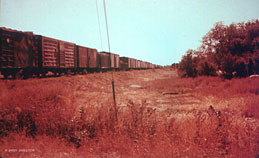 |
|
A
MoPac train passes behind a new suburb in the 48th-56th Street
area in the early 1960's. It still looking more like the farmland
it was when the line was originally built. This area will change
greatly from development over the next 10 years.
|
Big changes were
happening by late 1951. The ever forward-looking Missouri Pacific was
the first of Nebraska's major raillines to completely dieselize. This
meant jobs were cut back, the city-scape changed with the disappearance
of water and coaling towers and roundhouses. Even roads in Falls City
were affected as the city lost its source of cinders used on it's unpaved
streets. MP 486, a 2-8-0 was the last MoPac steam locomotive out of
Lincoln.
Nine years after
replacing the granduer of the old station, the modern joint MoPac/C&NW
passenger depot in Lincoln was itself demolished in 1962, with operations
moved to a freight office space the two railroads shared with a beer
company. For years the station was the departure point for trains, motorcars,
provide passenger service to and from Union, Nebraska to meet the sleek
Missouri River Eagle streamliner. By July of 1954 a Missouri Pacific
bus would take over the The Eaglet's 12-year assignment, with the motorcar
being moved further south to work in the warmer climate of Louisiana,
where Nebraska's deep snows couldn't lock it up in an icey grip. Depots
were disappearing in Elmwood, Eagle, Union and to the south in Talmage.
And eventually, like the others, the newest Lincoln freight office was
gone to make room for the highway overpass of Interstate 180 by 1986,
leaving only a few tracks as reminders under the new concrete bridges.
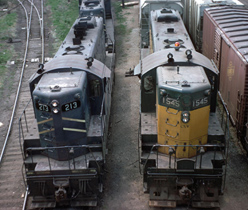 |
|
MP
213
and Chicago & NorthWestern 1545, - the Geeps offer comparative
views while switching cars at the joint MP/C&NW yard a stone's
throw from Memorial Stadium in Lincoln, Nebraska. The date is
April 19, 1974. - © copyright Glen Beans, used with permission
|
Over the years the
MoPac kept a solid presence along the branch line. The daytime switch
engine crew would build a train at Lincoln to be taken by a road crew
to Union, then back to Lincoln. In 1963 the late evening departures
were moved up to late afternoon... around 5 p.m., in order to get the
road engines back in time for the switch yard crew the next morning.
The railroad ran everything they had into Lincoln at some time or another,
but they did have some preferances for the branch. By the late1970's
the equipment had changed many times - gray and blue had long since
given way to solid blue for economy back in 1962. A pair of sleek new
GP15's or slightly older GP38-2's had replaced the aging GP7's and F7's,
which before them had replaced the varied mix of steam driven locos
like the Ten-Wheelers, the pride of passenger crews on the branch in
the 30's. But always the service continued as it had everyday except
on Sundays, a traditional rest day. Occasionally the day off was changed
for football Saturdays, and operations were suspended due to the Mopac's
close quarters to the University of Nebraska's Memorial Stadium... a
very wise decision in light of the crew's challenging efforts to switch
cars among rabid Big Red fans. When the city wished to expand "O"
Street to four lanes, the railroad replaced it's bridge over the street
in July 1971, becoming the largest rail landmark in town. For awhile,
a pair of new MP15ACs yard switchers, #1533 and 1532 were seen building
trains in the Lincoln yard during 1974. By the mid 1970's the through
train, #171 and 172 were performing the local switching operations.
The Lincoln switch crew was discontinued service in July 1975. This
left one train to do everything, occasionally with a switch crew being
brought back briefly during times of heavier traffic.
 |
Growing
up in the 70's with a railroad in your backyard
Five o'clock p.m...
except for the caw of a jay in the surrounding trees growing upon the
isolation of the surrounding hills, all was silence. This was another
world apart from the everyday suburbs hidden all around. Then in the
distance you'd look up, and there it was... a bright glimmering point
of light shining. We knew what it meant. It was coming! Not much longer
you could hear the horn blast and the light rose higher as it approached
the 48th Street bridge heading straight toward east. Now you could make
out a shape around the light. When the air and the ground both began
to rumble from the throb of EMD turbine engines, it seemed that any
kid on the block who wasn't already outside would rush out the backdoor
of their home to watch and wave.
As a kid, my family
lived close enough to the MoPac's Lincoln-Union line that you could
feel ground shake as the train passed. The MoPac was an overwhelming
sight of white warpaint (that's what the white nose chevrons reminded
me of), buzzsaws and billboard-sized screamin' eagles on the long hoods...
endless loads of graincars... trailers on flats of every color and boxcars
from all over the country. Sometimes we'd see loads of military tanks
or other vehicles on their way to the Nebraska National Guard. One engine
was affectionately known as "the Greaser", due to all the
oily residue clinging to it's sides. If we were quick and rich enough
we could crush a penny under the wheels of the heavy engines (the all-copper
pennies minted before '72 worked best).
 |
MP 1624 with her brakeman at the ready, the little GP7 rumbles
through the UNL campus on a clear white day in Lincoln, Nebraska
on March 5, 1976. Later it will make the 5pm run east to Union,
then back home to Lincoln around midnight. - © Glen Beans
Photo
|
Always there was
an enthusiastic wave from the conductor in his bright red caboose, he
must have gotten a swollen arm from all the waving he'd do each day
as he saw us fly past from high above in his cupola. We'd stand and
stare as the train rumbled away, going over the hump past at 56th Street,
until it was no longer in sight. The smell of diesel still hung in the
air as we turned back to our bicycle races or tv cartoon shows. Or maybe
just a few of us stayed behind, as we would search the gravel around
the rails for our newly flattened penny with all the wonders of the
smoke and noise of the MoPac still playing in our minds.
Mom always tried
to persuade me away from the rails, telling me if I got too close I'd
be sucked under the wheels. I didn't believe her... no engine traveling
at 20 miles an hour could do that. But still I always used caution whenever
near my stretch of track. Better to have a healthy respect and not to
push your luck with any train - you'll always come out the loser.
Now I'm not here
to defend what a bunch of us kids in my neighborhood did way back when
(if and when dads and moms found out our gooses were usually cooked
too). And I'm sad to say some of what we did was pretty stupid, even
for kids. I will confess that we took advantage of our apple tree and
delighted in using a passing hopper empty for target practice (locos
or cabooses were off limits) - the empties boomed like a humongous drum,
a pretty big sound for a little kid to make. Yes, we could be brats
at times... and darned lucky that no one was hurt either on the train
or the kids. There was always someone laying a rock or a branch or even
a spike on the rails just to see the aftermath of it being squished.
I lived directly beside the tracks, and I kind of had different ideas.
I had my own little patrol on the rails every day and knock any obstacles
off... sometimes rocks or 2x4's or fallen trees. A train derailment
into all these surrounding homes wasn't going to happen under my watch!
This wasn't the
only type of mayhem the neighborhood kids got into. Around about the
4th Grade, a friend of mine who we'll fictionally call Greg the Schemer,
had hatched a scheme to collect old rail spikes then selling the metal
to a scrapyard. Now there was always this rumor going around with us
kids for as long as I could remember - that rail spikes were worth their
weight in gold and ripe for the picking. Many had tried and all had
failed. But Greg had a plan. So after the school bell rang at 3:00pm
he ran out of the schoolyard to the rails nearby and began hunting for
spikes that had worked their way loose or had fallen off. The secret
to Greg's master plan was wearing his extra baggy jeans with big pockets
that day. With much sweat and toil, Greg pulled spikes and filled his
pockets with all the booty he could carry and with a noticeable swagger
he trotted off home. In his head I'm sure he happily dreamed of how
to spend every last cent of his soon to be had riches.
Then along after
5:00pm rolled by, not long after one expects all the neighborhood fathers
have gone home from a hard day's work, I happened to spot Greg back
working on the track. This time he was under very close adult supervision.
I couldn't hear what was said, but I imagine it was just as well. The
stern looking figure would point to the rails, then stand with hands
on hips and the poor Greg the Schemer pounded every spike he pilfered
into the hard cross ties with a small hammer. Oh the humiliation...
another great kid-idea bites the dust!

|
Sublettered
for Mopac subsidiary Texas & Pacific, #13103 is parked on the
college campus at Lincoln, Nebraska in October 1975. This evening
it will be headed back east to Union, then it or a sister will
make the return back again to Lincoln around midnight - ©
copyright Glen Beans Photo
|
At times the railroad
would bring on a few troubles itself. Now the trackage east from 40th
Street straight over the 48th Street concrete bridge, past the schoolyard
through to 56th was free from any crossings save for a single school
sidewalk. There
were times when the local crews were either faced with an over-full
yard or busy switching out cars, so thier solution was to park a long
cut of freight cars between 40th and 56th Streets (either for a few
hours in the morning, or since the previous night).
This gave the crew
a huge stretch - longer than the yard itself - to park cars without
impeding road traffic. Busy 48th Street now ran under the line (I believe
that the grade seperation was constructed around the 1950's). Unfortunately
someone didn't take into account the school kids who used the sidewalk
crossing the tracks to reach Riley Elementary School. Ten minutes before
the school bell rang at 9 a.m., kids everywhere were crawling through
the parked cars, under cars or tried to find a way around, oblivious
to the danger. Then pretty soon the cars would roll without warning
as the crew would finally clear the sidewalk The freight office received
some very pointed phonecalls those mornings.
The MoPac always
offered hours of entertainment for us kids, even when they were not
running trains. Finding old date nails imprinted way, way back in the
1920s and '30s was fun. We made it a competition to see who could find
the most colorful rock from the ballast bed - the ones with a bright
stripes of rusty orange mixed with black on white where more valuable
than diamonds, especially if it had a vein of glitter in it. The biggest
prize however were the ancient klinkers and coal cinders, perhaps dropped
off of one of the ten-wheelers that used to call Lincoln home. These
were sometimes bigger than both fists put together and reminded me of
something as exotic as a meteorite.
After a MoW gang
had been through our area performing some trackwork (the spreaders and
pullers put on an impressive show) we'd have fun picking-up the discarded
items, an empty track nail drum could always be used for an addition
to the clubhouse, and it was always cool to find a bent spike in the
shape of an "L". One lucky day I found a spike driver with
a split handle thrown into the weeds of a hillside - I still have that
relic today. The most exciting bit of equipment I was fortunate enough
to play with for some time was the speeder that a crewman parked behind
our home. I spent a whole weekend in my engineers cap and bandana playing
on that thing, waving off any possible dangers with a lantern and sounding
an imaginary airhorn.
As kids we'd sometimes
lay out on the dirt hill beside the right of way with our bikes, chewing
on a stalk of grass straw and wait for the train to come. To pass time
we'd have a Railwalking contest to see how far we could go before loosing
balance - I had alot of practice at this. There were always trestle
bridges and culverts with a little creek to explore. But we had to always
keep an eye on the horizon for a bright little speck of light. The line
was flat and straight enough that you could see a train approaching
miles away, long before you could hear the horn. As the engineer saw
us gathered to wave he'd give a blast of the horn or ring the bell which
made us jump and cheer.
 |
MP 2032, a GP38-2, which appears ready for the eastward run to
Union from Lincoln, Nebraska on March 5, 1976. - © Glen Beans
Photo
|
To give
a brief idea of rail operations in Lincoln during the years of the 1970-80's,
MoPac had direct access to many local industries. Lincoln Lumber and
Hyland Bros. - both lumber industries were located between 33rd and
20th Streets. Cushman Industries - renowned manufacturer of Cushman
golf carts, motor scooters, etc... was another major industry directly
linked to the line here. East of 17th Street the line crossed the CRIP
and the local switching company OL&B, who handled two of the larger
grain elevators in the city, as well as the Reimers-Kaufman/Ready Mix
plant which kept shipments of sand, gravel, lime & cement in constant
demand. Just west, north and northeast of Memorial Stadium the line
became the joint MP/CN&W rail yard. Here the two roads interchanged
freely and shared the freight office as well. Just southwest of the
yard were the team tracks, Lincoln Station, and the Haymarket district
where the MoPac interchanged with BN and UP. Finally the line terminated
into the UP line west of town and west of Salt Creek. Passenger
traffic was long gone, but the twin daily runs was as routine as day
and night.
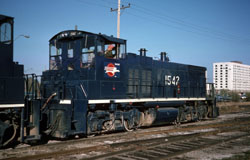 |
|
MP
#1547, a MP15
DC, switching cars at the joint MP/C&NW yard near Memorial Stadium
in Lincoln, Nebraska. Though it's November 1974, from the looks
of the bright red engineer's cap, it's easy to imagine things
haven't changed too much since the days of steam power. - ©
Glen Beans Photo
|
As a kid, the almost
endless summers of discovery of the tracks always held something for
us, whether it was the mechanical mystery of a work train plodding by
one day... or playing engineer on an orange pushcar parked behind my
home the next. Just about midnight the engine would make a return run
from Union back to its roost near Memorial Stadium. You could hear it
coming from a greater distance during the stillness of the night...
I could trace it's path past Cotner Boulevarde, then 56th Street in
my mind. The ground would vibrate and the windows rattle as the powerful
EMD engines got closer. I'd rise from my pillow and peek out my darkened
bedroom window that faced the track to see the sillouttes rush by as
a multitude of dancing "lightning bugs" signalled off and
on, as the familiar shapes made the track whir with the many steel wheels.
Some may think it a shame that we missed-out on the age of steam, but
us kids didn't care. Those were the best and biggest toys we ever had.
This was my world.
Merger
- the Big Mop-Up
Oftentimes the
MoPac would be seen cooperating with the Burlington Northern (formerly
the Chicago Burlington & Quincy), which had always been the rail
king in Lincoln. The cooperation was not only seen in Lincoln but across
both systems. The MoPac's philosophy saw a time of increased rail mergers
coming, and was determined to find an ideal partner to merge with rather
than be left behind in the future. The MoPac was always looking ahead.
Other roads such as the Rock Island had slipped here and withered away
into non-existence. Ultimately the prospects of a BN/MP union fell through,
as the the two systems overlapped and duplicated too many operations
to be profitable. The MoPac then turned it's eyes to the Omaha-based
Union Pacific and things began to happen. A merger was rumored... then
announced involving the UP, Western Pacific and the MoPac.
As reported in the
local papers in September, 1980, no lines on any of the three merging
railroads (Western Pacific, Union Pacific and the MoPac) were expected
to be abandoned as a result of the impending merger of the three rail
systems. Lincoln terminal operations were to be conslidated under a
joint facility agreement between M.P. and U.P. An additional U.P. zone
local train would operate to provide local freight service then handled
by MoPac in Lincoln. Except for routing improvements, there were to
be no major changes in operations in Nebraska outside of Omaha.
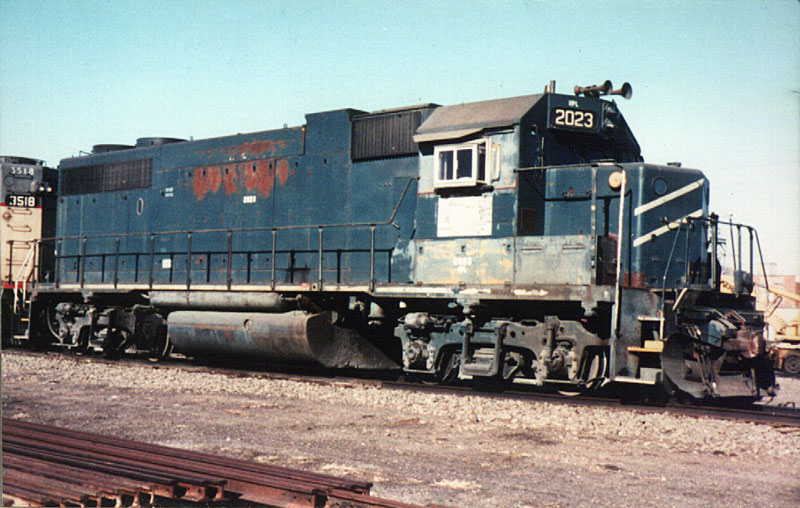 |
| MP
2023 - a
GP38-2 still a bluebird, but beginning
to show signs that it's being stripped of it's MP heritage. Lincoln,
Nebraska, 4/9/89 - Richard Wilson Photo/Todd Greuter Collection
|
When the merger
was announced, the MoPac was the larger system. The MoPac rails covered
more area than the Omaha based Union Pacific. MoPac owned more locomotives,
most of which were under 10-years old. It's fleet and operating facilities
were more modern using the cutting edge technology of the industry,
keeping with MoPac's philosophy. When the two systems were laid out
on a map, they met almost perfectly end-to-end, with little trackage
overlapping.
During the early
Eighties, the Missouri-Kansas-Texas line was seen running through Lincoln's
east campus neighborhoods over the Mopac. This was one of the first
signs of the impending merger going into effect, as the MKT exercised
it's new trackage rights, performing many of the operations the blue
MoPac Geeps had formerly done. After making a number of familiarization
trips over the "Siberian Subdivision", as the "Katy"
began calling it's new northern operations, the MKT took over and the
MoPac's presence began to disappear for the first time in memory. Service
to Lincoln slowed to semi-weekly, or even monthly at this time. By now
I was growing up and working for my dad. I missed witnessing the infrequent
action when it did happen behind our home. What a change it was to see
the Katy's green hues roll by where large Screaming Eagles once flew.
The daily 5pm MoPac freight out of Lincoln was a thing of the past.
Though they were still in use, the rails seemed almost forgotten. Still,
I had no idea what was about to happen next, even as I continued to
walk the rails and escape into my world.
 |
Missouri
-Kansas-Texas # 632 is resting between assignments at Lincoln,
Nebraska, 9/24/89 - photo James Gilley collection
|
 |
|
...the
sun sets upon the MoPac's Lincoln branch. Looking west to a local
MoPac landmark, the 48th St. Bridge and the former "Peck's
Grove" area.
|
Abandonment
Disaster happened
in 1984 when heavy flooding damaged the steel rails, totally washing
away a bridge crossing just west of the town of Weeping Water. The price
for repairs along the tracks would be high... very high for a 47-mile
long branchline.
There was a growing
lack of sufficient revenue from the the smaller towns to keep up with
the costs of modern railroading. The trucking industry was beginning
to bite into the profits that formerly belonged to only the line. And
the city of Lincoln had been pressuring the MoPac to build a new route,
one going around the city, and abandon the long used trackage - which
now found itself cutting straight through a busy, growing city that
seemed to have popped-up overnight from the once endless grain fields.
Perhaps the branchline was a victim of it's own success. There were
growing conflicts with traffic, including a tragic collision between
an outbound locomotive and a fire engine in 1981 that was in the headlines
for weeks.
Bob Soflin witnessed
these crashes from his own home. "Unfortunately, I also witnessed
two horrible incidents when the Eaglet was late one winter evening and
collided with a car at 66th before any signals were installed and there
were two fatalities."
"Again, I witnessed
the terrible accident with the Station 9 fire truck at Cotner &
Vine and the daily freight ... I can still see the fire truck spinning
like a top as the train came to a stop heading east on it's way to Union.
I knew one of the fireman that was killed, Harley Grasmic, as he was
thrown from the drivers seat and run over by the train. But, again those
are things that become imbedded in your mind and are apart of the railroad
heritage as, with anything else, human error and accidents will always
occur."
The merger with
the Union Pacific provided alternate access to Lincoln, the UP rails
ran well around the city. All of these ingedients had been brewing for
years under the surface, waiting for the right moment to combine for
the inevitable result. The railroad deemed to petition for abandonment
of the right-of-way between Weeping Water and Lincoln, just two years
short of the branch's 100th anniversary in favor of access to Lincoln
via the Union Pacific trackage. The towns of Wabash, Elmwood, Eagle,
and Walton which sprouted and prospered alongside the line had been
axed from the system. Weeping Water too, lost direct routes to Lincoln
and Omaha, but had kept busy enough moving cars to and from Union and
Louisville.
The last rail activity
I remember seeing from my backyard consisted of the strange sight of
a short string of yellow passenger cars, likely a UP inspection train.
There hadn't been any traffic on the rails for so long... and I wouldn't
see it again.
With a train of
three covered hoppers, MoPac GP15 #1668 made the final trip from Lincoln
to Elmwood and back on August 2, 1986. On May 13, 1988, scrapping of
the branch from Lincoln's 33rd Street all the way to Elmwood began.
In a just a matter
of a few years the Missouri Pacific Railroad, the blue engines with
their white eagles and war-paint on the nose, the friendly wave from
a bright red caboose, and ultimately the tracks themselves were all
gone. The right-of-way, which had once rumbled daily with passengers
filled with hopes and dreams, and supplies of grain, coal, lumber and
goods to nourish a small college town into a prosperous city, has been
preserved today as a very popular 30-mile long bike path... still puncuated
by the caws of bluejays in the shadey elm trees.
 |
|
The
Missouri Pacific track rises then cuts through a hill west of 56th
St. in Lincoln in the 1970's. Back in 1886, this area was part of
the Thomson farm when, at 3:40 pm on August 14, the final spike
was driven, finishing the Lincoln segment witnessed by about 50
onlookers on horse-drawn carriages. Regular rail service would begin
on the 25th with almost an entire trainload of coal, followed two
hours later by the first passenger train, almost full without advance
publicity, headed for Weeping Water.
|
An
Update
After the UP/MP/WP
merger , Union Pacific took over the MoPac branchline from Lincoln to
the Falls City Sub at Union. With the bridge washout from the 1984 floods,
the UP opted to cut the west end of this line between Weeping Water
and Lincoln. That left the ex-MP track running only as far as 35th Street
in Lincoln for interchanging with the Omaha, Lincoln & Beatrice next
door to the fairgrounds.
 |
A
paired set of former Missouri Pacific GP38-2's, now in U.P. paint,
change cars on old MoPac rails on a hazy Saturday afternoon, Lincoln,
Nebraska. Once a common site, now this too has
also passed into history with the final abandonment of the remaining
line by Union Pacific.
6/3/95 - T. Greuter photo |
The University of
Nebraska wanted the land the belonging to the line as it now cuts through
a portion of the campus. After years and years of pressure from the
University and City dating back to pre-merger days, the UP began pulling-up
these last rails in the Summer/Fall of 2000. Only track from the OL&B
interchange (18th Street) to Lincoln Lumber (23rd Street) remains with
segments yet to be removed between 27th & 33rd Street. It's was
assumed that the UP would interchange with the OL&B by trackage rights
to be secured over BNSF's Omaha Line between 9th Street and 17th Street,
but it's been observed that BNSF is handling the switching between the
two companies.
By mid-summer UP
the standard Geep pair assigned to Lincoln were called elsewhere as
the company ceased its switching crew operations in Lincoln.
Union is still an
important stopping point on the KC-Omaha mainline. Switching operations
continue along the remainder of the Branch to the limestone, concrete,
and fertilzer industries of Weeping Water and Louisville.
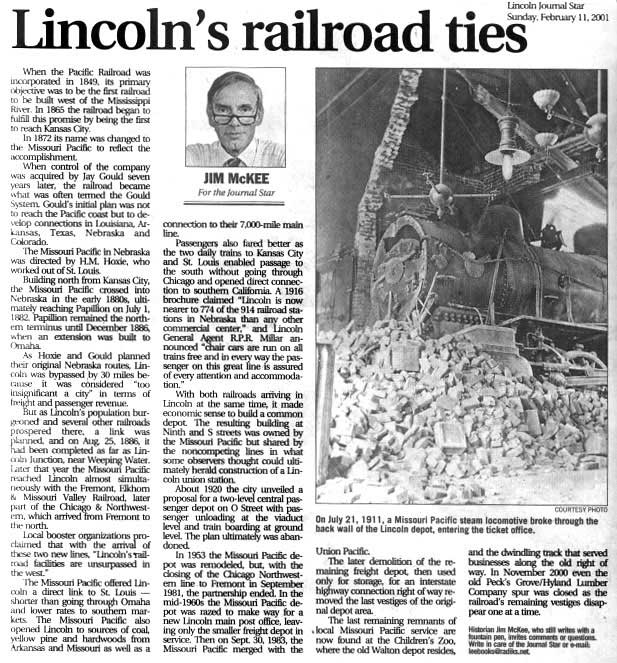 |
|
Pictured
is a MoPac locomotive that crashed through the wall of the Lincoln
depot into the ticket office in 1911.
Story courtesy of Jim McKee, Lincoln Journal-Star. Used with permission.
Click
on Article to read at Full-size
|
|